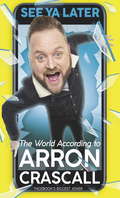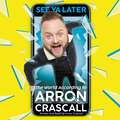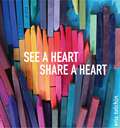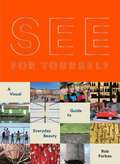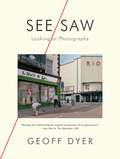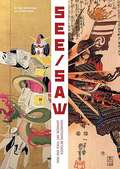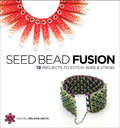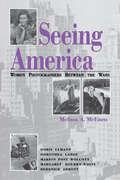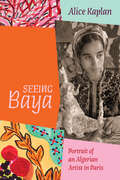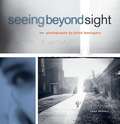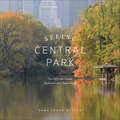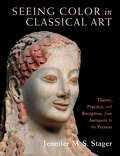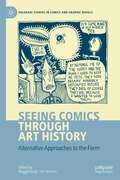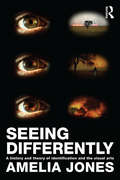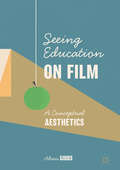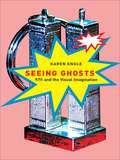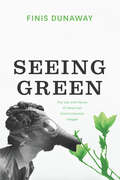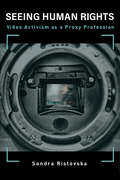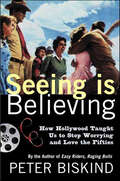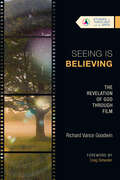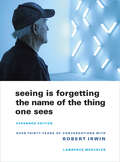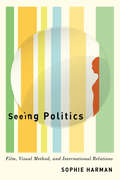- Table View
- List View
See Ya Later: The World According to Arron Crascall
by Arron CrascallAlright guys? It's me, Arron. Or as some people call me, 'that guy with the phone, the skinny jeans and the really fat head'.In a world that seems to be freefalling without a parachute towards utter chaos, I'm here to remind you that when life gives you lemons, make lemonade. No, in fact, when life gives you lemons, make a fool out of yourself in the lemonade aisle.*Because there's more to life than Brexit, Bake Off and banging on about being vegan. Yes, with this book - which is my take on the world - you will learn how to survive a proper lads' holiday, become a master in the art of takeaway ordering and find out about the pitfalls of seriously inappropriate tattoos.So do yourself a favour: turn off the news, cancel that juice cleanse, open your eyes to the brilliant, hilarious world we live in and most importantly . . . buy this book.SEE YA LATER! Arron x*Actually, don't do exactly that, that's my thing.
See Ya Later: The World According to Arron Crascall
by Arron CrascallArron Crascall is one of the UK's leading social media stars. Millions watch his videos online and he's guaranteed to bring a little bit of hilarity into your day.This book is his take on the world. The things that are important to Arron. The good, the bad and the stupid (there's a lot of this third one). You'll find stories about his past, a lot of views on the present and some opinions on how to make the future a more enjoyable place. It's part biography, part self-help book, part text book, part travel book (well, Dover at least), you'll find comedy, crime, drama, romance, and you'll even learn a thing or two about astro-physics (he's not even joking). In fact, he's putting so much into this book, you won't just see it in every bookshop in the country, you'll see it on every shelf in every bookshop in the country.Welcome to the world according to Arron Crascall. SEE YA LATER!
See Ya Later: The World According to Arron Crascall
by Arron CrascallAlright guys? It's me, Arron. Or as some people call me, 'that guy with the phone, the skinny jeans and the really fat head'.In a world that seems to be freefalling without a parachute towards utter chaos, I'm here to remind you that when life gives you lemons, make lemonade. No, in fact, when life gives you lemons, make a fool out of yourself in the lemonade aisle.*Because there's more to life than Brexit, Bake Off and banging on about being vegan. Yes, with this book - which is my take on the world - you will learn how to survive a proper lads' holiday, become a master in the art of takeaway ordering and find out about the pitfalls of seriously inappropriate tattoos.So do yourself a favour: turn off the news, cancel that juice cleanse, open your eyes to the brilliant, hilarious world we live in and most importantly . . . buy this book.SEE YA LATER! Arron x*Actually, don't do exactly that, that's my thing.Written and Read by Arron Crascall(p) Orion Publishing Group 2017
See a Heart, Share a Heart
by Eric TelchinA gift that opens your eyes, your heart, and your world In 2009, Eric Telchin noticed a heart in a pool of melted ice cream, and hearts have followed him ever since. He launched boyseeshearts.com as a forum to share his "found" hearts, and an Internet phenomenon was born. This enticing book pairs Eric's photography with short, poignant text to create the ultimate gift for anyone looking to lend, mend, or charm a heart. The simple message of being open to seeing hearts and finding love is one that will resonate with readers of all ages. Anyone can see hearts; it's just a matter of remembering to look for them.
See for Yourself
by Rob ForbesThis accessible handbook from design guru Rob Forbes uncovers the beauty in the commonplace and reveals how visual thinking can enrich our lives. In friendly text complemented by photographs taken on his travels around the world, Forbes explains how to appreciate the design elements that surround us in the built environment. Linking broad concepts such as composition and materiality to quotidian details such as the play of color in hanging laundry or the repeated forms in a row of ice cream scoops, Forbes reveals how an appreciation of the hues, patterns, and textures that surround us can enhance a life well lived. See for Yourself is essential reading to see more clearly, think more visually, and enjoy the world more deeply.
See/Saw: Looking at Photographs
by Geoff DyerA lavishly illustrated history of photography in essays by the author of Otherwise Known as the Human ConditionSee/Saw shows how photographs frame and change our perspective on the world. Taking in photographers from early in the last century to the present day—including artists such as Eugène Atget, Vivian Maier, Roy DeCarava, and Alex Webb—the celebrated writer Geoff Dyer offers a series of moving, witty, prescient, surprising, and intimate encounters with images.Dyer has been writing about photography for thirty years, and this tour de force of visual scrutiny and stylistic flair gathers his lively, engaged criticism over the course of a decade. A rich addition to Dyer’s The Ongoing Moment, and heir to Roland Barthes’s Camera Lucida, Susan Sontag’s On Photography, and John Berger’s Understanding a Photograph, See/Saw shows how a photograph can simultaneously record and invent the world, revealing a brilliant seer at work. It is a paean to art and art writing by one of the liveliest critics of our day.
See/saw: Connections Between Japanese Art Then And Now
by Ivan Vartanian Kyoko WadaSee/Saw offers a provocative new look at the origins of Japanese pop art. Often defined by its references to manga or anime, contemporary Japanese art in fact has much broader roots. By drawing parallels between the art of Japan past and present, this compelling volume reveals how current artists rework the traditional forms and techniques of Japanese art history. Modern takes on time-honored conventions are illustrated by the work of a star-studded roster of contemporary artists including Tabaimo, Makoto Aida, Takashi Murakami, Yoshitomo Nara, and Yayoi Kusama. Aficionados of both contemporary and traditional Japan are sure to appreciate this fresh perspective on art and the power of visual culture.
Seed Bead Fusion: 18 Projects to Stitch, Wire, and String
by Rachel Nelson-SmithThis fresh design approach to seed-bead jewelry will teach you how to fuse, merge, and mix materials and techniques, colors, inspiration, and design ideas for seed-bead jewelry with a contemporary edge.Seed Bead Fusion is all about:Fusing materials, techniques, and inspiration that creates eye-catching seed-bead jewelry.Mixing silver and copper wire, seed beads, Czech glass, and crystals for a unique melange of materials.Combining wirework with seed beads, beadweaving with wire, stringing with beadweaving, and multiple beadweaving stitches in a single piece to create extraordinary sculptural seed-bead jewelry.Finding design inspiration from a wide range of sources, including Indian Punjabi folk costumes and Native American beading.Detailed step-by-step photography adds a workshop aspect to the book.All of the basic beadweaving stitches, basic wirework, and stringing techniques are shown as illustrations in a getting-started section. The 18 projects are an inspired mixing of techniques in a single piece.
Seeing America: Women Photographers Between the Wars
by Melissa A. McEuen“This vibrant and penetrating study. . . . opens a window on American culture between the world wars.” —Publishers WeeklySeeing America explores the camera work of five women who directed their visions toward influencing social policy and cultural theory. Taken together, they visually articulated the essential ideas occupying the American consciousness in the years between the world wars.Melissa McEuen examines the work of Doris Ulmann, who made portraits of celebrated artists in urban areas and lesser-known craftspeople in rural places; Dorothea Lange, who magnified human dignity in the midst of poverty and unemployment; Marion Post Wolcott, a steadfast believer in collective strength as the antidote to social ills and the best defense against future challenges; Margaret Bourke-White, who applied avant-garde advertising techniques in her exploration of the human condition; and Berenice Abbott, a devoted observer of the continuous motion and chaotic energy that characterized the modern cityscape.Combining feminist biography with analysis of visual texts, McEuen considers the various prisms though which each woman saw and revealed America.Winner of the 1999 Emily Toth Award for the best feminist study of popular culture given by the Women’s Caucus of the Popular Culture Association.“A rich resource for anyone interested in the history of photography, women’s history, and American history in general.” —Bloomsbury Review“A valiant, well-researched effort to bridge the history of visual culture with American social and political history.” —Journal of American History“The best books always leave their audience wanting more. That is certainly true of this gem of a work.” —Library Journal (starred review).
Seeing Baya: Portrait of an Algerian Artist in Paris (Abakanowicz Arts and Culture Collection)
by Alice KaplanThe first biography of the Algerian artist Baya Mahieddine, celebrated in mid-twentieth-century Paris, her life shrouded in myth. On a flower farm in colonial Algeria, a servant and field worker known as Baya escaped the drudgery of her labor by coloring the skirts in fashion magazines. Three years later, in November 1947, her paintings and fanciful clay beasts were featured in a solo show in Paris. She wasn’t yet sixteen years old. In this first biography of Baya, Alice Kaplan tells the story of a young woman seemingly trapped in subsistence who becomes a sensation in the French capital, then mysteriously fades from the history of modern art—only to reemerge after independence as an icon of Algerian artistic heritage. The toast of Paris for the 1947 season, Baya inspired colonialist fantasies about her “primitive” genius as well as genuine appreciation. She was featured in newspapers, on the radio, and in a newsreel; her art was praised by Breton and Camus, Marchand and Braque. At the dawn of Algerian liberation, her appearance in Paris was used to stage the illusion of French-Algerian friendship, while horrific French massacres in Algeria were still fresh in memory. Kaplan uncovers the central figures in Baya’s life and the role they played in her artistic career. Among the most poignant was Marguerite Caminat-McEwen-Benhoura, who took Baya from her sister’s farm to Algiers, where Baya worked as Marguerite’s maid and was given paint and brushes. A complex and endearing character, Marguerite—and her Pygmalion ambitions—was decisive in shaping Baya’s destiny. Kaplan also looks closely at Baya’s earliest paintings with an eye to their themes, their palette and design, and their enduring influence. In vivid prose that brings Baya’s story into the present, Kaplan’s book, the fruit of scrupulous research in Algiers, Blida, Paris, and Provence, allows us to see in a whole new light the beloved artist who signed her paintings simply “Baya.”
Seeing Beyond Sight: Photographs by Blind Teenagers
by Tony DeifellFor five years Tony Deifell taught teenagers to take photographs. His students were blind. Unusual as the idea may seem at first, putting cameras in the hands of visually impaired children proved to be extremely fruitful both for the photographers, who found an astonishing new means of self-expression, and for the viewers of their images, for whom this is an entirely new kind of dreamlike and intuitive creation. Even before you know that these pictures were taken by blind teenagers, they are striking in their use of light and composition, and haunting in their chiaroscuro intensity. To learn more, visit http://www.seeingbeyondsight.org/
Seeing Central Park: The Official Guide
by Sara Cedar MillerAn authoritative visual survey of New York City’s Central Park, with new photography and updated text.For more than 160 years, Central Park has been the centerpiece of New York City, with more than forty-two million visits each year. In Seeing Central Park, Sara Cedar Miller takes readers through America’s most popular and celebrated park, where natural and manmade features are interwoven into a spectacular work of art. Combining superb research and writing with breathtaking photographs, Seeing Central Park is not only a guide through every significant design feature but also a gorgeous gift book.Since the book was first published in 2009, the Conservancy has completed a number of renovations and opened new areas of the park, including the Hallett Nature Sanctuary, Rhododendron Mile, and Dene Slope. This updated edition features these landmarks alongside revised entries and new photography throughout. With its pastoral and picturesque landscapes, roads and paths, bridges, buildings, structures, and sculpture, Central Park is a living museum of superb Victorian decorative arts and landscape design. From the Pond to Harlem Meer, it’s all covered in Seeing Central Park.
Seeing Color in Classical Art: Theory, Practice, and Reception, from Antiquity to the Present
by Jennifer M. StagerThe remains of ancient Mediterranean art and architecture that have survived over the centuries present the modern viewer with images of white, the color of the stone often used for sculpture. Antiquarian debates and recent scholarship, however, have challenged this aspect of ancient sculpture. There is now a consensus that sculpture produced in the ancient Mediterranean world, as well as art objects in other media, were, in fact, polychromatic. Color has consequently become one of the most important issues in the study of classical art. Jennifer Stager's landmark book makes a vital contribution to this discussion. Analyzing the dyes, pigments, stones, earth, and metals found in ancient art works, along with the language that writers in antiquity used to describe color, she examines the traces of color in a variety of media. Stager also discusses the significance of a reception history that has emphasized whiteness, revealing how ancient artistic practice and ancient philosophies of color significantly influenced one another.
Seeing Comics through Art History: Alternative Approaches to the Form (Palgrave Studies in Comics and Graphic Novels)
by Ian Horton Maggie GrayThis book explores what the methodologies of Art History might offer Comics Studies, in terms of addressing overlooked aspects of aesthetics, form, materiality, perception and visual style. As well as considering what Art History proposes of comic scholarship, including the questioning of some of its deep-rooted categories and procedures, it also appraises what comics and Comics Studies afford and ask of Art History. This book draws together the work of international scholars applying art-historical methodologies to the study of a range of comic strips, books, cartoons, graphic novels and manga, who, as well as being researchers, are also educators, artists, designers, curators, producers, librarians, editors, and writers, with some undertaking practice-based research. Many are trained art historians, but others come from, have migrated into, or straddle other disciplines, such as Comparative Literature, American Literature, Cultural Studies, Visual Studies, and a range of subjects within Art & Design practice.
Seeing Differently: A History and Theory of Identification and the Visual Arts
by Amelia JonesSeeing Differently offers a history and theory of ideas about identity in relation to visual arts discourses and practices in Euro-American culture, from early modern beliefs that art is an expression of an individual, the painted image a "world picture" expressing a comprehensive and coherent point of view, to the rise of identity politics after WWII in the art world and beyond. The book is both a history of these ideas (for example, tracing the dominance of a binary model of self and other from Hegel through classic 1970s identity politics) and a political response to the common claim in art and popular political discourse that we are "beyond" or "post-" identity. In challenging this latter claim, Seeing Differently critically examines how and why we "identify" works of art with an expressive subjectivity, noting the impossibility of claiming we are "post-identity" given the persistence of beliefs in art discourse and broader visual culture about who the subject "is," and offers a new theory of how to think this kind of identification in a more thoughtful and self-reflexive way. Ultimately, Seeing Differently offers a mode of thinking identification as a "queer feminist durational" process that can never be fully resolved but must be accounted for in thinking about art and visual culture. Queer feminist durationality is a mode of relational interpretation that affects both "art" and "interpreter," potentially making us more aware of how we evaluate and give value to art and other kinds of visual culture.
Seeing Education on Film: A Conceptual Aesthetics
by Alexis GibbsThis book argues that certain films have more to offer by way of conceptualising education than textual scholarship. Drawing on the work of the later Wittgenstein, it suggests that a shift in our philosophical focus from knowing to seeing can allow for ordinary educational phenomena (teachers, schools, children) to be appreciated anew. The book argues that cinema is the medium best placed to draw attention to this revaluation of the everyday, and particular films are presented as offering unique insights into the aesthetic nature of education as a concept. The book will be of primary interest to educators and educationalists alike, but its interdisciplinary nature should also appeal to those in the fields of film study, philosophy, and aesthetics.
Seeing Ghosts
by Karen EngleStarting from the tremendous fascination with images of 9/11, Karen Engle asks what, in the context of a national trauma, makes an image appropriate or scandalous, exploring how diverse visual media have been mobilized in political projects of identification and personal narratives of empathy. Focusing on themes of memory, mourning, and history, Engle examines sculptural, photographic, and new media responses to the 9/11 attacks in both contemporary and historical contexts, considers the public's reaction to these visual productions, and suggests that earlier presentations of America at war play a pivotal role in the representations of 9/11 in both official and popular media.
Seeing Green: The Use and Abuse of American Environmental Images
by Finis DunawayAmerican environmentalism is defined by its icons: the "Crying Indian,” who shed a tear in response to litter and pollution; the cooling towers of Three Mile Island, site of a notorious nuclear accident; the sorrowful spectacle of oil-soaked wildlife following the ExxonValdez spill; and, more recently, Al Gore delivering his global warming slide show in An Inconvenient Truth. These images, and others like them, have helped make environmental consciousness central to American public culture. Yet most historical accounts ignore the crucial role images have played in the making of popular environmentalism, let alone the ways that they have obscured other environmental truths. Finis Dunaway closes that gap with Seeing Green. Considering a wide array of images--including pictures in popular magazines, television news, advertisements, cartoons, films, and political posters--he shows how popular environmentalism has been entwined with mass media spectacles of crisis. Beginning with radioactive fallout and pesticides during the 1960s and ending with global warming today, he focuses on key moments in which media images provoked environmental anxiety but also prescribed limited forms of action. Moreover, he shows how the media have blamed individual consumers for environmental degradation and thus deflected attention from corporate and government responsibility. Ultimately, Dunaway argues, iconic images have impeded efforts to realize--or even imagine--sustainable visions of the future. Generously illustrated, this innovative book will appeal to anyone interested in the history of environmentalism or in the power of the media to shape our politics and public life.
Seeing Human Rights: Video Activism as a Proxy Profession (Information Policy)
by Sandra RistovskaAs video becomes an important tool to expose injustice, an examination of how human rights organizations are seeking to professionalize video activism.Visual imagery is at the heart of humanitarian and human rights activism, and video has become a key tool in these efforts. The Saffron Revolution in Myanmar, the Green Movement in Iran, and Black Lives Matter in the United States have all used video to expose injustice. In Seeing Human Rights, Sandra Ristovska examines how human rights organizations are seeking to professionalize video activism through video production, verification standards, and training. The result, she argues, is a proxy profession that uses human rights videos to tap into journalism, the law, and political advocacy.Ristovska explains that this proxy profession retains some tactical flexibility in its use of video while giving up on the more radical potential and imaginative scope of video activism as a cultural practice. Drawing on detailed analysis of legal cases and videos as well as extensive interviews with staff members of such organizations as Amnesty International, Human Rights Watch, WITNESS, the International Criminal Tribunal for the former Yugoslavia (ICTY), and the International Criminal Court (ICC), Ristovska considers the unique affordances of video and examines the unfolding relationships among journalists, human rights organizations, activists, and citizens in global crisis reporting. She offers a case study of the visual turn in the law; describes advocacy and marketing strategies; and argues that the transformation of video activism into a proxy profession privileges institutional and legal spaces over broader constituencies for public good.
Seeing Is Believing: How Hollywood Taught Us to Stop Worrying and Love the Fifties
by Peter BiskindSeeing is Believing is a provocative, shrewd, witty look at the Hollywood fifties movies we all love-or love to hate-and the thousand subtle ways they reflect the political tensions of the decade. Peter Biskind, former executive editor of Premiere, is one of our most astute cultural critics. Here he concentrates on the films everybody saw but nobody really looked at--classics like Giant, On the Waterfront, Rebel Without a Cause, and Invasion of the Body Snatchers--and shows us how movies that appear to be politically innocent in fact carry an ideological burden. As we see organization men and rugged individualists, housewives and career women, cops and doctors, teen angels and teenage werewolves fight it out across the screen from suburbia to the farthest reaches of the cosmos, we understand that we have been watching one long dispute about how to be a man, a woman, an American--the conflicts of the period in action. A work of brilliant analysis and meticulous conception, Seeing Is Believing offers fascinating insights into how to read films of any era.
Seeing Is Believing: The Revelation of God Through Film (Studies in Theology and the Arts Series)
by Richard Vance GoodwinHow might film reveal God?In its most basic form, film is a series of images displayed over time. Of course, film has developed greatly since the Lumière brothers by adding components such as sound, special effects, digital recording, and more to create an increasingly complex artistic medium. Historically, film studies has often focused on the narrative aspect of film as it seeks to tell a story. More recent studies, however, have turned attention to other elements of film, such as the musical score. Yet, film remains, in a sense, a series of images.In this study, the latest in IVP Academic's Studies in Theology and the Arts (STA) series, theologian Richard Goodwin considers how the images that constitute film might be a conduit of God's revelation. By considering works by Carl Theodor Dreyer, Stanley Kubrick, Paul Thomas Anderson, Robert Bresson, Martin Scorsese, Terrence Malick, and more, Goodwin argues that by inviting emotional responses, film images can be a medium of divine revelation.Blessed are those who have seen God... through film.
Seeing Is Forgetting the Name of the Thing One Sees: Expanded Edition
by Lawrence WechslerWhen this book first appeared in 1982, it introduced readers to Robert Irwin, the Los Angeles artist "who one day got hooked on his own curiosity and decided to live it." Now expanded to include six additional chapters and twenty-four pages of color plates, Seeing Is Forgetting the Name of the Thing One Sees chronicles three decades of conversation between Lawrence Weschler and light and space master Irwin. It surveys many of Irwin's site-conditioned projects—in particular the Central Gardens at the Getty Museum (the subject of an epic battle with the site's principal architect, Richard Meier) and the design that transformed an abandoned Hudson Valley factory into Dia's new Beacon campus—enhancing what many had already considered the best book ever on an artist.
Seeing Orange (Orca Echoes)
by Sara CassidySeven-year-old Leland has trouble writing, but he loves drawing. Leland so dislikes his teacher that he conjures up Delilah, an imaginary seeing-eye dog to help him into class each day. When a neighborhood painter recognizes Leland's gifts as an artist, Leland grows more confident about the world as he uniquely sees it. And when his family's cat goes missing, it is Leland's keen observation skills that lead to finding him. Leland's newfound confidence helps him both confront and sympathize with his teacher, who only wishes Leland could be a bit more focused. The epub edition of this title is fully accessible.
Seeing Politics: Film, Visual Method, and International Relations
by Sophie HarmanPushing the boundaries of how we do research, how we communicate research, and what counts as scholarship in world politics.
Seeing Politics: Film, Visual Method, and International Relations
by Sophie HarmanVisual politics and the aesthetic turn in international relations have emphasized the power of the image in world politics. Postcolonial and decolonial feminist theory shows the urgent need to rethink research and teaching methods. What happens when these concepts converge and such thinking is translated into practice? Engaging with a broad range of topics – the politics of everyday life, health, HIV/AIDS, Africa, post-colonialism, gender/feminist theory, visuality, film, and method – in Seeing Politics Sophie Harman looks at scholars who are pushing the boundaries of how they do research, how they communicate their research to a broader audience, and what counts as scholarship in world politics. Through a detailed exploration of the political process of film production, from inception and co-production to distribution and exhibition, she addresses the tricky transnational relationships, government gatekeeping, and global hierarchies of film governance that control and marginalize the stories and people we see. Fundamentally, Seeing Politics is about how narrative feature film challenges and advances the discipline of international relations, revealing aspects of politics that would otherwise remain unseen and unaddressed. Film is not just a way of communicating research. It is a method that produces research and visibility, advancing research practice and knowledge in international relations. Innovative and compelling, this book is about the politics of seeing, being seen, and what stops us from seeing.
